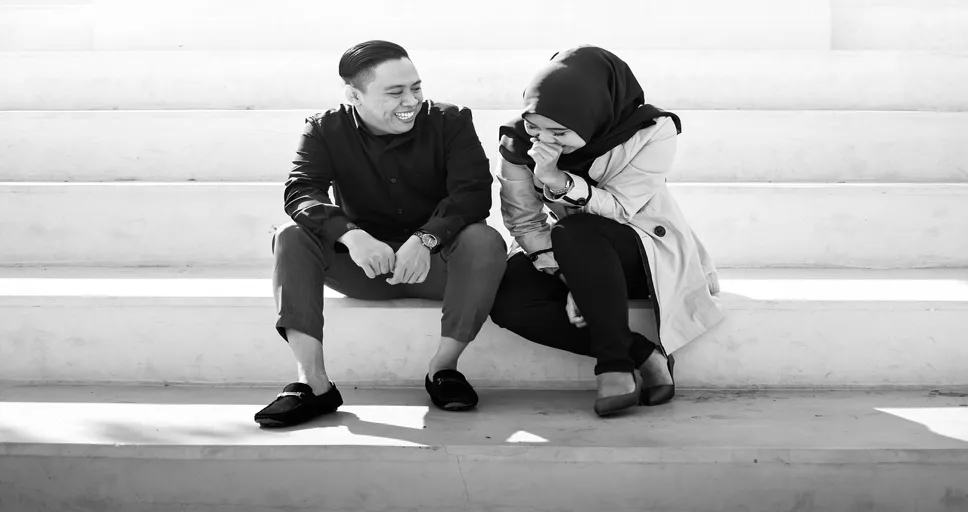Contents
- 1 Am I Flirting Without Realizing It? Identifying Unconscious Flirting Behaviors
- 2 The Psychology Behind Unconscious Flirting
- 3 Common Misinterpretations of Friendly Behavior
- 4 The Impact of Social Media on Unconscious Flirting
- 5 Setting Boundaries: How to Be Mindful of Your Interactions
- 6 Navigating Mixed Signals in Relationships and Friendships
- 7 Frequently Asked Questions
- 7.1 Do people flirt without realizing it?
- 7.2 Why do I flirt unconsciously?
- 7.3 How do I know if I am flirting?
- 7.4 Am I flirting without realizing it?
- 7.5 Why do I flirt without knowing?
- 7.6 How do I stop being unintentionally flirty?
- 7.7 What is an accidental flirt?
- 7.8 How do I stop flirting without realizing it?
- 7.9 Is it possible to flirt unintentionally?
- 7.10 Is it possible to subconsciously flirt?
- 7.11 What is an example of accidental flirting?
- 8 Conclusion: Embracing Self-Awareness and Clarity in Interactions
- 9 Recommended Authors For Further Reading
Asking yourself “am I flirting without realizing it” is the first step toward understanding the subtle cues and behaviors that constitute unconscious flirting. Often, these actions are automatic, reflecting our innate social and emotional instincts. Unconscious flirting can range from a simple smile or prolonged eye contact to more involved actions like playful teasing or finding reasons to touch someone lightly. Recognizing these behaviors in ourselves can be surprising, as they may not align with our conscious intentions.
Understanding unconscious flirting is crucial not just for personal insight but also for navigating social interactions more mindfully. It helps in distinguishing between friendly behavior and genuine romantic interest, preventing potential misunderstandings. This awareness is especially pertinent in today’s interconnected world, where digital communications can blur the lines between platonic and romantic interactions. By becoming more aware of the signals we emit and receive, we can foster clearer and more meaningful connections with those around us.
- Recognize signs of unconscious flirting: prolonged eye contact, playful teasing, light touching, and mirroring body language.
- Reflect on your interactions, especially with those you feel drawn to, to identify unintentional flirting behaviors.
- Understand digital flirting through frequent messaging, use of emojis, and social media interactions beyond normal contexts.
- Acknowledge that unconscious flirting can stem from evolutionary cues, social conditioning, dopamine release, and emotional needs.
- Distinguish between friendly behavior and romantic interest to prevent misunderstandings and clarify intentions.
- Practice mindfulness in social interactions to ensure your actions align with your intentions and foster meaningful connections.
Am I Flirting Without Realizing It? Identifying Unconscious Flirting Behaviors
The question “am I flirting without realizing it” often arises when we find ourselves in the grey area between friendly banter and romantic interest. This section delves into the subtle, often subconscious, behaviors that may signal flirting, helping you identify when you’re sending out signals you might not be aware of.
Body Language Cues
One of the most telling signs of unconscious flirting is body language. Open, inviting postures, such as leaning in during a conversation or mirroring the other person’s actions, suggest a level of comfort and interest that goes beyond casual interaction. Eye contact, too, is a powerful communicator; holding someone’s gaze slightly longer than usual can convey attraction, even if you’re not fully aware of it.
Verbal Indicators
The way we speak can also reveal unintentional flirting. Playful teasing, sharing personal anecdotes, or asking probing questions about the other person’s life might be your way of showing interest without consciously deciding to flirt. Laughter, particularly when you find yourself laughing more easily and frequently with a specific person, can also be a sign that you’re enjoying a deeper connection, potentially blurring the lines between friendliness and flirtation.
Physical Contact
Touching someone casually, such as a light touch on the arm or shoulder during a conversation, is another common unconscious flirting behavior. These gestures can signify comfort and a desire to be closer, even if your conscious mind hasn’t labeled your behavior as flirting.
Digital Flirting
In the digital age, flirting can also occur through text messages and social media interactions. Frequent and enthusiastic messaging, especially outside of normal social or work-related contexts, can be a form of unconscious flirting. Emojis, particularly those with romantic or suggestive connotations, often play a role in signaling interest that you might not express face-to-face.
Recognizing the Signs in Yourself
Identifying these behaviors in yourself can be challenging, as they often occur without deliberate intent. Reflecting on your interactions with others, especially those you’re drawn to, can help you become more aware of your unconscious signals. This awareness allows you to navigate social situations more mindfully, ensuring your actions align with your intentions.
Unconscious flirting doesn’t always mean you’re interested in a romantic relationship. It can simply be a way of expressing friendliness or enjoying the company of others. However, understanding these signals can help you clarify your feelings and intentions, both to yourself and to the people around you.
The Psychology Behind Unconscious Flirting
Unconscious flirting can often leave one pondering, “am I flirting without realizing it?” This behavior stems from deep-rooted psychological processes that govern human interactions and attraction. Understanding these subconscious mechanisms can shed light on why we sometimes flirt without conscious intention.
Evolutionary Perspectives
From an evolutionary standpoint, flirting behaviors may be hardwired into our DNA as a means of signaling interest and suitability as a mate. These non-verbal cues, such as eye contact, smiling, and mirroring, serve as a prelude to potential romantic involvement. They occur naturally and instinctively, often bypassing our conscious awareness.
Social Conditioning
Our upbringing and cultural background significantly influence our interpersonal behaviors, including flirting. Social norms dictate what is considered appropriate in interactions between individuals, leading to variations in how people flirt across different cultures. This conditioning can result in unconscious flirting behaviors that align with one’s social expectations, even if the individual is not actively seeking a romantic connection.
The Role of Dopamine
The brain’s reward system plays a crucial role in unconscious flirting. Dopamine, a neurotransmitter associated with pleasure and reward, is released during enjoyable social interactions, including those involving flirtatious behavior. This chemical response can encourage continued engagement in flirting, sometimes outside of our conscious control, as we seek the positive feelings associated with these interactions.
Emotional Needs and Self-Esteem
Flirting unconsciously can also be a reflection of underlying emotional needs or desires for validation and self-esteem enhancement. Receiving positive attention from others can boost one’s self-worth, making the act of flirting a beneficial, albeit subconscious, strategy for feeling valued and attractive.
Misinterpretation of Signals
Sometimes, the question “am I flirting without realizing it?” arises from misinterpretations of our behavior by others. What one person considers to be friendly and polite behavior might be perceived as flirtatious by someone else. This discrepancy often stems from differences in personal boundaries, expectations, and interpretations of social cues.
Recognizing and Understanding Unconscious Flirting
Becoming aware of your unconscious flirting behaviors requires self-reflection and mindfulness in social interactions. Paying attention to your body language, tone of voice, and how others react to your behavior can help you identify patterns that might be interpreted as flirting. Understanding the psychological motivations behind these actions allows for greater control over how you present yourself and interact with others, ensuring that your behavior aligns with your intentions.
In conclusion, the psychology behind unconscious flirting is complex, involving a mixture of evolutionary biology, social conditioning, neurological responses, and personal emotional needs. Recognizing these factors can help demystify why we might flirt without intending to, offering insights into our social behavior and relationships.
Common Misinterpretations of Friendly Behavior

Navigating the fine line between friendliness and flirting can often lead to the question, “am I flirting without realizing it?” This confusion is frequently rooted in common misinterpretations of friendly behavior, where actions meant as purely platonic are perceived as flirtatious. Understanding these misinterpretations can help clarify intentions and improve communication in social interactions.
The Ambiguity of Physical Touch
Physical touch, such as a pat on the back or a friendly hug, is one of the most common behaviors misinterpreted as flirting. In many cultures, such gestures are normal among friends and signify camaraderie or support. However, because touch is also a key component of romantic interactions, it can be easy to misconstrue these actions as signals of romantic interest.
Laughter and Compliments
Laughing at someone’s jokes or offering compliments can also be perceived as signs of flirting. While these behaviors are often meant to be friendly and encouraging, they can sometimes send mixed signals, especially if the laughter or compliments are frequent or particularly enthusiastic. This can lead someone to wonder if their actions are being interpreted as flirting, even when no romantic interest exists.
Eye Contact and Smiling
Maintaining eye contact and smiling during a conversation are typically seen as indicators of attentiveness and interest. While these are essential components of engaging communication, they can also be misread as flirtatious interest. The intensity and duration of eye contact, along with the context of the smile, play significant roles in how these actions are interpreted.
Social Media Interactions
In the digital age, interactions on social media platforms can also be easily misinterpreted. Liking, commenting on, or sharing someone’s posts can be seen as forms of friendly engagement. However, if these interactions are frequent or overly personal, they may be viewed as signs of flirting. The public nature of social media further complicates these perceptions, as the intentions behind digital interactions are harder to gauge.
Context and Cultural Differences
The context in which behavior occurs greatly influences its interpretation. For example, a friendly hug in a social setting may be seen differently than the same gesture in a professional environment. Cultural differences also play a crucial role in how behaviors are perceived. Actions considered friendly in one culture may be seen as overly intimate or flirtatious in another, leading to confusion and misinterpretations.
Recognizing the potential for friendly behaviors to be misinterpreted as flirting is crucial for navigating social interactions smoothly. By being mindful of how your actions might be perceived and considering the context and cultural norms, you can help ensure that your intentions are clear. This awareness can prevent misunderstandings and help answer the question, “am I flirting without realizing it?” with greater confidence and clarity.
The Impact of Social Media on Unconscious Flirting
In an era where digital communication reigns supreme, the lines between friendly banter and flirting can become blurred, leading many to wonder, “am I flirting without realizing it?” particularly in the realm of social media. This section explores how social media platforms have amplified the potential for unconscious flirting, altering the way we perceive and engage in flirtatious behavior.
Enhanced Connectivity and Constant Interaction
Social media enables constant connectivity, allowing for immediate and ongoing interactions with friends, acquaintances, and even strangers. This constant availability increases the opportunities for casual conversations that can quickly veer into flirtatious territory, often without the participants’ full awareness. The ease of sending a quick message or comment makes it simpler to engage in behaviors that might be considered flirtatious in a face-to-face setting.
Anonymity and False Sense of Privacy
The relative anonymity and privacy offered by social media can encourage more bold and flirtatious interactions. Individuals may feel more confident expressing themselves in ways they wouldn’t in person, leading to unconscious flirting. This false sense of privacy can make it easier to cross boundaries unknowingly, as the digital barrier reduces the immediate social cues and consequences present in physical interactions.
Ambiguity of Digital Communication
Without the benefit of tone, body language, and immediate feedback, digital communications on social media are ripe for misinterpretation. A playful emoji, gif, or comment can be seen as flirtatious, even if the sender intended it as a friendly gesture. This ambiguity often results in confusion over whether interactions constitute flirting, leaving individuals questioning their behavior and intentions.
The Role of Visuals in Unconscious Flirting
Social media platforms are heavily visual, with photos and videos being primary modes of communication. The act of liking or commenting on someone’s pictures can be perceived as showing interest or attraction, contributing to unconscious flirting. The visual nature of these platforms can accentuate physical attraction and lead to interactions that might not occur in non-digital settings.
Hyper-Personalization and Selective Sharing
The curated nature of social media profiles allows individuals to present themselves in a selectively positive light, often emphasizing attributes they find appealing or desirable. This hyper-personalization can lead to increased attention and interactions that may be interpreted as flirtatious. Engaging with someone’s carefully chosen content can inadvertently send signals of interest, further complicating the distinction between friendly engagement and unconscious flirting.
Social media has undoubtedly complicated the dynamics of flirting, blending friendly interaction with romantic intention in ways that are not always clear. Recognizing the impact of digital platforms on our social behaviors can help individuals navigate their interactions more mindfully, ensuring that their online conduct aligns with their real-world intentions. As we continue to grapple with these blurred lines, the question “am I flirting without realizing it?” becomes increasingly relevant, prompting a closer examination of our digital interactions.
Setting Boundaries: How to Be Mindful of Your Interactions

In the complex dance of social interactions, the question “am I flirting without realizing it?” highlights the need for setting clear boundaries to navigate relationships mindfully. Establishing and respecting personal and interpersonal boundaries is crucial in ensuring that our actions align with our intentions and are perceived accurately by others. This section explores practical strategies for setting boundaries that help distinguish between friendly and flirtatious interactions.
Understanding Your Comfort Zone
The first step in setting boundaries is understanding your own comfort zone. Reflect on your interactions and identify what types of behaviors you consider friendly versus those you perceive as flirtatious. Recognizing your boundaries allows you to communicate them clearly to others, reducing the likelihood of misunderstandings.
Clear Communication
Effective communication is key to setting and maintaining boundaries. Be open and honest about your comfort levels with friends, colleagues, and potential romantic interests. If you feel that an interaction is veering into territory that makes you uncomfortable, express your feelings clearly and respectfully. Clear communication helps prevent situations where someone might wonder, “am I flirting without realizing it?” by ensuring that all parties understand each other’s intentions.
Digital Boundaries
With the prevalence of social media and digital communication, setting digital boundaries is equally important. Be mindful of the content you share and the messages you send. Think about how your online interactions might be perceived and consider setting limits on who can see your posts or send you messages. This mindfulness can help prevent unintentional flirting and maintain the intended tone in your digital interactions.
Recognizing and Respecting Others’ Boundaries
Just as you set your own boundaries, it’s important to recognize and respect the boundaries of others. Pay attention to verbal and non-verbal cues that indicate someone’s comfort level with your interactions. If someone communicates their boundaries to you, respect their wishes without pushing for more intimate interactions. This mutual respect is crucial in maintaining healthy and appropriate relationships.
In situations where the intentions behind interactions are unclear, it’s important to navigate the ambiguity with sensitivity. If you’re unsure whether your behavior could be interpreted as flirting, consider asking for feedback or clarifying your intentions. This proactive approach can prevent misunderstandings and ensure that both parties are comfortable with the nature of their interactions.
Reflecting on Intentions
Regularly reflect on your intentions behind your interactions with others. If you find yourself questioning, “am I flirting without realizing it?” take a moment to consider your motives. Are you seeking a deeper connection, or are you simply enjoying a platonic friendship? Being honest with yourself about your intentions can help guide your behavior and ensure it aligns with your desired outcomes.
Setting boundaries is an ongoing process that requires awareness, communication, and respect. By being mindful of your interactions and the signals you send and receive, you can navigate the complex landscape of social relationships with confidence and clarity. This mindfulness ensures that your actions are understood as intended, reducing the likelihood of unintentional flirting and fostering healthier, more meaningful connections.
In the intricate dance of human interaction, deciphering the line between friendliness and romantic interest can be challenging, leading many to wonder, “am I flirting without realizing it?” Mixed signals often arise in relationships and friendships, creating confusion and potential misunderstandings. This section offers insights into navigating these ambiguous waters, ensuring clearer communication and understanding between all parties involved.
Understanding the Source of Mixed Signals
Mixed signals can stem from a variety of sources, including differences in communication styles, personal boundaries, and individual perceptions of what constitutes flirting. Recognizing that these discrepancies exist is the first step in navigating mixed signals. It’s important to approach such situations with an open mind, acknowledging that the intention behind actions may not always align with how they are perceived.
Communication is Key
Clear and open communication is paramount when dealing with mixed signals. If you’re on the receiving end of what you perceive as mixed signals, consider addressing the situation directly. A conversation can clarify intentions and feelings, reducing the chances of further misinterpretation. Similarly, if you’re concerned that your actions might be misread, taking the initiative to explain your behavior can help maintain the integrity of the relationship or friendship.
Context Matters
The context in which interactions occur plays a significant role in how they are interpreted. Social cues, environmental factors, and the nature of your relationship with the other person all influence the perception of whether behavior is friendly or flirtatious. Paying attention to these contextual clues can aid in correctly interpreting signals and adjusting your behavior accordingly.
Reflect on Your Feelings and Intentions
If you find yourself questioning, “am I flirting without realizing it?” it may be time to reflect on your own feelings and intentions. Understanding your emotions towards the person sending mixed signals can clarify whether you’re hoping for a friendship or something more. This self-awareness can guide your responses and help you communicate more effectively about your desires and boundaries.
Seek Outside Perspectives
Sometimes, an outside perspective can provide clarity on a situation clouded by mixed signals. Talking to a trusted friend about your interactions can help you see the circumstances from a different angle and decide on the best course of action. However, remember that the ultimate understanding of your relationship or friendship comes from direct communication between the involved parties.
Prioritize Respect and Honesty
Regardless of the nature of your relationship or friendship, respecting the other person’s feelings and being honest about your own is crucial. This respect and honesty form the foundation of any healthy interaction, enabling both parties to navigate mixed signals without compromising the relationship’s integrity.
Navigating mixed signals in relationships and friendships requires a balance of self-awareness, clear communication, and sensitivity to the other person’s feelings. By approaching ambiguous situations with an open mind and a commitment to understanding, you can minimize confusion and build stronger, more transparent connections with those around you.
- Unconscious flirting includes behaviors like smiling, prolonged eye contact, playful teasing, and light touching, often without realizing it.
- Recognizing these actions in oneself is key to navigating social interactions more mindfully and preventing misunderstandings.
- Body language, verbal indicators, and digital communications are common channels of unconscious flirting.
- Unconscious flirting stems from deep-rooted psychological processes, including evolutionary signals, social conditioning, dopamine release, and emotional needs.
- Awareness of one’s own flirting behaviors can clarify intentions and improve interpersonal connections, distinguishing between friendliness and romantic interest.
Frequently Asked Questions

Do people flirt without realizing it?
Yes, people can flirt without realizing it, often because their behavior is naturally playful or charismatic, which can be interpreted as flirting.
Why do I flirt unconsciously?
Unconscious flirting can happen due to natural charm, the habit of being overly friendly, or simply enjoying the thrill of engaging with others in a playful manner.
How do I know if I am flirting?
You may be flirting if you find yourself engaging in playful or suggestive conversation, making prolonged eye contact, or showing more interest in someone than usual.
Am I flirting without realizing it?
If people often interpret your friendliness or jokes as romantic interest, you might be flirting without realizing it.
Why do I flirt without knowing?
You might flirt without knowing due to a naturally engaging personality, a habit of being affectionate with friends, or misunderstanding social cues.
How do I stop being unintentionally flirty?
To stop being unintentionally flirty, be mindful of your actions and words, maintain professional boundaries, and be clear about your intentions in interactions.
What is an accidental flirt?
An accidental flirt is someone who sends flirtatious signals without intending to, often because of their naturally friendly or charming behavior.
How do I stop flirting without realizing it?
Becoming aware of your behavior, reflecting on feedback from others, and consciously adjusting your interactions can help you stop flirting without realizing it.
Is it possible to flirt unintentionally?
Yes, it is possible to flirt unintentionally, often due to misinterpreted friendliness or habitual behaviors that resemble flirting.
Is it possible to subconsciously flirt?
Yes, people can subconsciously flirt, acting on underlying attractions or desires without conscious awareness.
What is an example of accidental flirting?
Accidental flirting can include laughing excessively at someone’s jokes, touching them casually, or paying them excessive compliments, all without romantic intent.
Conclusion: Embracing Self-Awareness and Clarity in Interactions
In the journey to understand the nuances of our social behaviors, particularly when deciphering if we’re flirting without intent, the key lies in embracing self-awareness and striving for clarity in all interactions. The question “am I flirting without realizing it?” serves as a catalyst for deeper introspection, urging us to reflect on the subtle cues we emit and receive in the dance of human connection. This exploration is not just about identifying instances of unconscious flirting but also about recognizing the impact our actions have on the dynamics of our relationships and friendships.
The Power of Self-Awareness
Self-awareness is the cornerstone of navigating the complex terrain of interpersonal relationships. It involves a conscious understanding of our emotions, intentions, and the signals we project through our behavior. By cultivating self-awareness, we empower ourselves to align our actions with our intentions, ensuring that our friendly gestures are received as such and not misconstrued as something more.
The Importance of Clear Communication
Clarity in communication acts as a bridge between self-awareness and mutual understanding. It’s essential for articulating our boundaries, expressing our feelings, and clarifying our intentions. In situations where mixed signals might arise, clear communication can dispel confusion and prevent misunderstandings, fostering a foundation of trust and respect in our interactions.
In today’s digital age, where social media plays a significant role in how we connect with others, the importance of clarity extends to our online interactions. The principles of self-awareness and clear communication are just as relevant in the digital sphere, where the absence of physical cues can amplify the potential for misinterpretation. By applying these principles to both real-world and digital interactions, we can navigate the complexities of modern relationships with greater confidence and understanding.
Fostering Healthy Relationships
Ultimately, the goal is to foster healthy, respectful relationships and friendships grounded in mutual understanding and clear communication. Whether we’re interacting face-to-face or through screens, the ability to reflect on our behavior and communicate effectively is invaluable. It enables us to build connections that are enriching and fulfilling, free from the ambiguity of unintended signals.
Moving Forward with Intention
As we move forward, let the question “am i flirting without realizing it?” serve not as a source of anxiety but as a prompt for growth and learning. Embracing self-awareness and prioritizing clarity in our interactions allows us to navigate the complexities of human connection with grace and intentionality. In doing so, we cultivate relationships that reflect our true selves and the depth of our connections with those around us.
Recommended Authors For Further Reading

- Deborah Tannen – Tannen is a sociolinguist whose work focuses on how language use affects and reflects relationships, providing insight into communication patterns that can be perceived as flirting.
- Leil Lowndes – Lowndes is an author who specializes in communication strategies to help individuals become more charismatic, including understanding the subtleties of flirting and social signals.
- Barbara Pease – Together with Allan Pease, Barbara Pease explores body language and the unspoken elements of communication, offering insights into how actions can be interpreted as flirtatious behavior.
- Allan Pease – Partnering with Barbara Pease, Allan’s work on body language and the psychology of relationships sheds light on how one might flirt unintentionally through non-verbal cues.
- Joe Navarro – A former FBI agent and an expert on body language, Navarro’s books provide a deep dive into understanding how our unconscious actions, including potential flirting signals, communicate much more than we realize.


